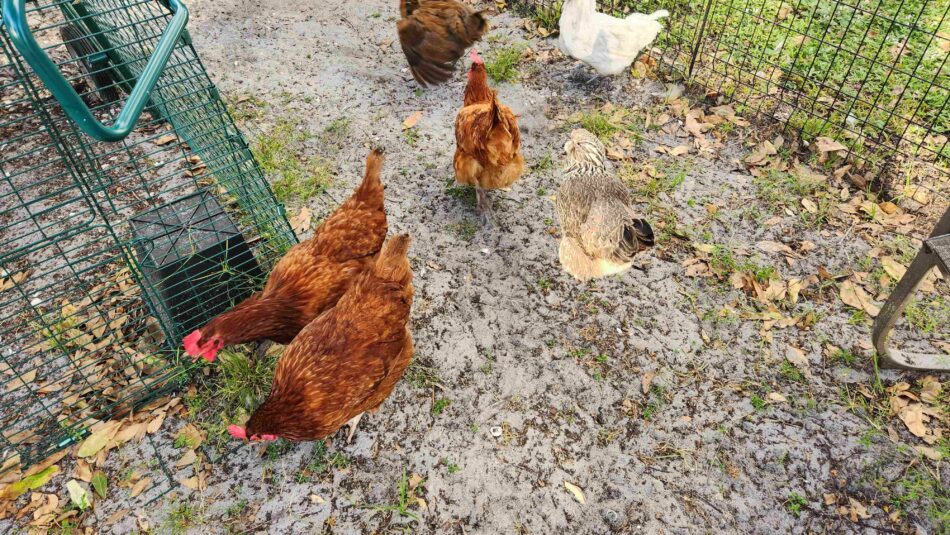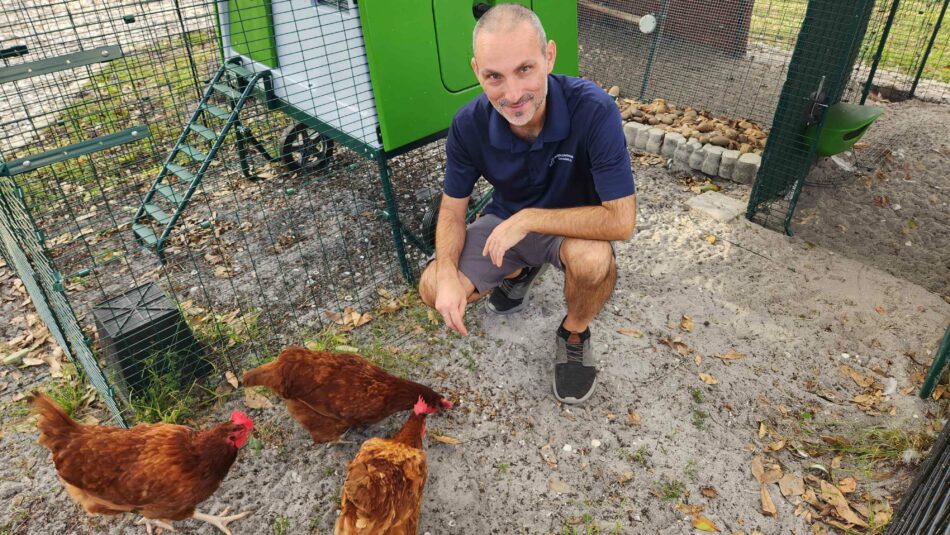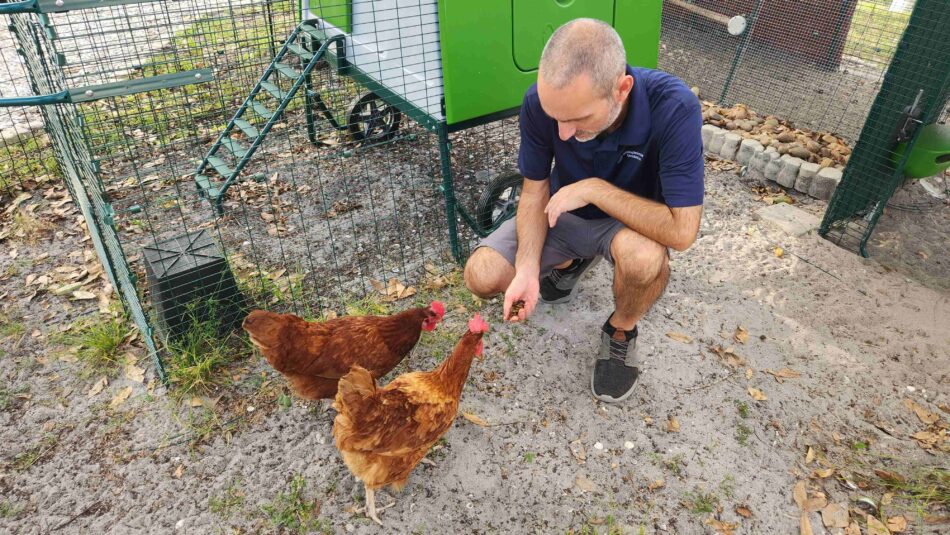Jeremy Gary’s guide to chicken moulting
Jeremy Gary lives in Venice, Florida. He’s a husband, father to 2 boys, proud chicken owner, and an Omlet Ambassador. Most of his chicken-keeping knowledge came through trial and error, as well as seeking advice from experienced local chicken keepers. Long before becoming an Omlet Ambassador, Gary purchased his first Omlet product. It was an Eglu Cube. And its design transformed the experience of keeping chickens for his family. In Gary’s professional life, he owns and operates a building science consulting business. Knowledge of temperature and moisture dynamics in the hot, humid Florida climate has proven very helpful in keeping chickens. In Gary’s spare time, he enjoys spending time with his family doing outdoor activities – his favourite of which is paddleboarding over to the beach for a few hours before sunset.
As chicken owners, we all want the best for our feathered friends. With a little time and some trial and error, we settle into a routine of chicken care that works for our flock. Everything is going great. The chickens are happy and healthy, and we feel like we really understand the needs of our flock. And then one day, feathers suddenly appear on the ground. At first, there are one or two here and there. And then, a whole bunch of them start to appear. What’s going on? Don’t worry, this is a natural process that all chickens go through called moulting. Moulting is the natural process of feather replacement in chickens. With a little extra care and attention, we can help our feathered friends through the moulting process. Omlet has some thoughtfully designed products that can help promote a clean, safe, and comfortable environment which is critical during this period.
How to spot moulting
Let’s talk a little bit about what chicken moulting is and how to recognize it. Moulting is a normal and beneficial process for chickens that helps them renew their feathers and prepare for the changing of the season. Chickens shed their old feathers and grow new ones. It’s a natural and necessary cycle that helps chickens to maintain both their health and appearance. Feathers are important for chickens because they provide insulation and protection. The moulting process allows chickens to replace damaged, worn out, or dirty feathers with fresh, clean, and strong new feathers. Molting usually occurs once a year, but it can vary depending on the breed, age, and environment of the chicken.
All animals go through some type of change as summer gives way to fall in preparation for the change of seasons. Dogs, for example, may shed a summer coat in favour of a winter coat. Wild birds in the northern hemisphere will fly south for the winter. Other animals simply hibernate to wait out the winter until spring returns. For chickens, the seasonal transition often involves the process of moulting. Understanding what moulting is and why it occurs is important for all chicken owners. Once we understand that it is both normal and natural, we can best help support our flock throughout the process.
The 3 phases of molting
Moulting can take anywhere from a few weeks to a few months, depending on the individual chicken. During the moulting process, a chicken’s behaviour can change significantly. For example, a chicken may stop laying eggs, reduce their overall activity, or lose their appetite. It isn’t uncommon for chickens to be irritable during molting, or maybe even a little socially reluctant. They may choose to spend more time by themselves away from the rest of the flock. Every chicken will react just a bit differently to the moulting process. Just remember that this is a normal, natural occurrence in their lives. But nonetheless, it’s a stressful time for them.
There are 3 basic phases of moulting: the pre-moulting phase, the moulting phase, and the post-moulting phase.
Phase one
The first phase is the pre-molting phase. Think of this as the resting period before moulting begins. This is where you may notice behavioural changes, such as reduced activity, a smaller appetite, and an end to egg-laying. The purpose of the pre-moulting stage is to conserve energy and to prepare for feather replacement. Shedding and replacing feathers requires lots of energy! This pre-molting phase can last anywhere from a few days to a few weeks.
Phase two
The second phase is the actual moulting phase. This is the time when a chicken will begin to lose its feathers. Feather loss will typically occur in a pattern, beginning at the head and neck and then working back toward the tail. During this time, a chicken may look bare and patchy. Throughout the moulting process, chickens are often more irritable and may shy away from other birds. Seeing this significant change in behaviour can be very stressful to a chicken owner if you don’t understand exactly what is causing it and why it is occurring.
Phase three
The third and final phase of the moulting process is the post-moulting phase, or the regrowth phase. New feathers will start to grow in from follicles where the old feathers fell out. The new feathers are often referred to as pin feathers and can look like little thin spikes with a waxy coating. New-growth feathers are sensitive and can be easily damaged. You may notice that your chicken is preening more than usual as they work to remove the wax coating and fluff up their new feathers. After a few weeks, the new feather growth will be complete, and your chicken will regain its normal appearance. Physical activity and social interaction with the flock return to normal, as will egg laying.

Helping your hens through their moult
During the moulting process, proper nutrition is essential to helping your chickens to grow healthy, new feathers. Replacing feathers is a high-energy activity! A diet with lots of protein is key. A feed with high-protein content can be helpful. Many chicken owners will substitute additional protein during the moulting period in the form of high-protein treats. Mealworms and soldier fly larvae are excellent sources of protein that your flock will love. Always make sure your flock has access to clean, fresh drinking water. This is important every day, but especially during moulting.
While chickens are going through the moulting process, there are a few simple things that chicken owners can do to help them through this stressful time.
- Avoid disturbing chickens unnecessarily during the moulting period. Moulting can make chickens more sensitive and irritable than normal. Handle your chickens gently during this time. And be extra patient and understanding if they want a little alone time.
- Keep your chickens safe and comfortable. Molting can make chickens more vulnerable to heat, cold, rain and snow, as well as to predators. Adequate shelter and protection from the elements and potential threats can be a big help.
- A high-protein diet to support feather growth is essential. You can supplement their feed with treats such as mealworms, soldier fly larvae or sunflower seeds.
- Clean, fresh water is essential for hydration during moulting. And a clean coop will prevent parasites and infections, which can worsen moulting or cause infections during this vulnerable time.
Omlet and your flock’s molt
And here is where the Omlet family of products can play a vital role in supporting your flock during the moulting process by providing safety and comfort. The unique construction of the Omlet Eglu Cube Chicken Coop lends itself to clean coop keeping, with its unique and easy-to-clean plastic design. The durable construction keeps chickens safe from predators during the vulnerable moulting period. And finally, comfort. The Eglu Cube is designed with chicken comfort in mind – everything from ventilation to superior insulation.
Moulting in your area
Depending on where you live, the needs of your chickens during the moulting period may be different. For example, if you live in an environment that may have cold temperatures during the moulting period, you may want to provide a little extra warmth to help with some of the exposed areas of the chicken’s body.
We live in SW Florida, so cold isn’t a problem in the fall. In fact, it is the opposite – heat and humidity can still be an issue. Even in October! We have a very hot and humid summer that seems to last forever. Moulting will often begin just as the stress of making it through a long summer is winding down for the chickens. To help them through, we always provide plenty of shade and icy treats. Things like ice cubes in their water or frozen watermelon to snack on. For protein-rich snacks, our flock loves soldier fly larvae.
By understanding what the moulting process is, you can provide great care and support for your flock to help them through this stressful time. By providing your flock with a few key things like a protein-rich diet and a safe, clean, and comfortable shelter, your chickens will emerge from the moulting process with a brand-new set of feathers to last them all year long. Oh, I almost forgot to mention the most important thing of all to help your flock through moulting – an extra-large portion of chicken-owner love!
Omlet has a great line of products that can serve your flock during the moulting process but throughout the entire chicken-raising process. They have truly unique and well-designed products that have transformed our chicken-keeping experience. Before becoming an Omlet Ambassador, I was the proud owner of several of their products. I encourage you to reach out to Omlet to learn more about how their family of products can help transform your chicken-keeping experience as it did for our family.
Our Eglu Cube even survived a Category 4 hurricane. But that’s a story for another blog post.
This entry was posted in Chickens


